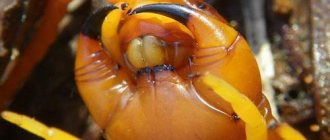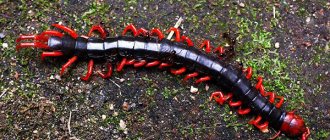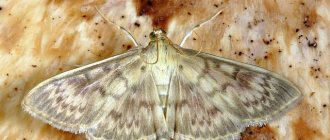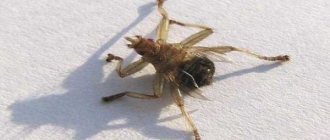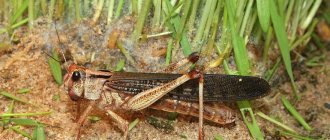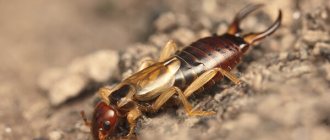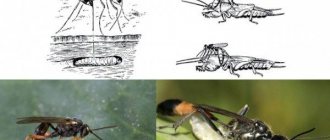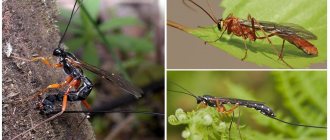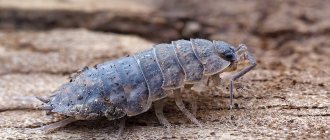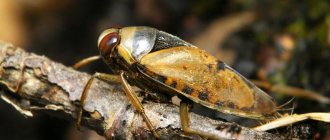Not every person knows what “arthropod scolopendras” are. Biologists call the lip centipede Chilopoda. In very warm climates it grows up to 25 centimeters in length.
Scolopendras are insects that live alone. They can be found in limestone caves with high humidity.
An encounter with such a species can be dangerous for a person. It is especially important not to fall under the attack of a large scolopendra in nature when the sun is warm.
Structure and appearance
Scientists consider the scolopendra to be an arthropod. She belongs to the genus of labiopods. Invertebrates are nocturnal inhabitants, hiding from sunlight. Some species see well and have excellent eyesight. Other breeds only distinguish between light and dark.
In order not to confuse insects with another species, it is better to know what centipedes look like. The legs have poisonous spines, so touching the insect to the human body causes severe irritation.
At the site of the bite there is severe redness, burning, and sometimes pain. The affected area of the body quickly becomes swollen, sometimes itches, and causes some discomfort.
The animal has a long body connected by plates and legs growing from it. The overall appearance is ugly and unpleasant to most people.
The structure of the scolopendra is as follows:
- head;
- eyes;
- antennae;
- poisonous legs under the head;
- front canines;
- the last limbs are anchors.
With the help of its many legs, the scolopendra grabs its prey so tightly that it cannot escape. The color of the centipede varies and depends on its habitat.
There are yellow, greenish, orange, brown species. Individuals can change color as they develop, which allows them to reliably hide among stones and grass from enemies.
The hind legs of the animal contribute to the adhesion of the individual to the surface of the walls, ceiling, and floor. The limbs help to stay on the vertical surface of the walls, and the front paws grab the victim.
The number of legs of a flycatcher varies widely. The multi-legged “poison factory” is a true killer of small and large insects.
Medium-sized individuals have a soft, long body. Its plates are connected to each other by flexible membranes. The body consists of chitin, which does not allow the insect to grow. Scolopendra can grow only after molting.
The armored arthropod is unpleasant to look at. During the day it hides under stones, only at night it crawls out to get food for itself. The centipede runs very fast because it feels uncomfortable in an open space and tends to quickly hide inside some crevice.
Externally, the animal looks like a caterpillar . Many legs protrude from a long, ugly body. Individuals living in nature usually have a color close to “khaki”.
Nature took good care that arthropods were able to camouflage themselves well among stones and greenery. Therefore, a person often does not notice the centipede and is easily attacked by it.
Chemicals for pests
The most reliable way to get rid of centipedes and other centipedes is chemical insecticides. You should choose drugs of medium and low toxicity, suitable for use in residential areas. It is necessary to treat places where scolopendras are supposed to enter and live: basements, storage rooms, bathrooms.
Among the most effective means:
Insecticides in the form of a spray, the main active substances are permethrin and cypermethrin. The products are sprayed in areas where centipedes are expected to live. The spray will help immobilize an accidentally discovered scolopendra, after which it can be taken out of the room.
Powder containing up to 40% pure cypermethrin. Before use, dilute with water in accordance with the instructions. The solution is sprayed along baseboards, in corners, and at thresholds. After drying, the product becomes safe for people and pets. The protective effect lasts up to 3 months.
Dry powder that is scattered under furniture, along baseboards, under window sills. Safe for people and pets. It acts on centipedes gradually, drying out their body. At the same time, it destroys other crawling insects: various centipedes, woodlice, cockroaches.
Synthetic pyrethroid in the form of a liquid concentrate
Before spraying, dilute with water in the required proportion. The product is suitable for treating residential premises indoors and outdoors. For maximum effect, spray baseboards, cracks under windows, external walls near doorways, all kinds of holes and gaps. Avoid contact with skin and respiratory tract.
When working with toxic drugs, it is important to follow safety rules, protecting your face with a mask or respirator, and your hands with rubber gloves. Insecticides are harmful to children and pets. After treatment, it is necessary to ventilate the room.
If you notice a single centipede in an apartment, you should not panic. Perhaps the arthropod ended up here by chance and lives alone. You should not douse the entire room with insecticides: first you should do a general cleaning, ventilate the rooms and get rid of pests that can attract predatory centipedes.
Habitats
Scolopendra lives in various areas with tropical climates:
- in South American countries;
- in Australia;
- on European territory;
- in Ukraine;
- In Russian federation;
- in the eastern regions;
- in Moldova;
- In Kazakhstan;
- in North Africa;
- in the Middle East.
When individuals look for shelter, they may well settle inside residential buildings, rooms with a humid climate - basements, bathrooms.
People often encounter disgusting-looking scolopendras in the bathrooms of houses and apartments, which is due to the fact that arthropods have chosen sewage drains.
The habitat of centipedes is dry leaves with black soil, rocky and grassy areas of rocks, caves. There arthropods feel safe and comfortable.
Places where centipedes are found are often located on the coast. Arthropods also like to live underground. They are thermophilic and cannot tolerate very low temperatures.
When it gets colder, hunting invertebrate insects becomes more difficult. When hunting, the scolopendra relies only on its own instincts; its vision is poorly developed. The animal can only distinguish between light and darkness.
In Russia
Not every person knows where centipedes live in Russia.
Habitats include:
- Transcaucasia.
- Crimea.
In Transcaucasia, individuals have chosen rocky cliffs and caves, where during the day they can hide inside crevices. Arthropods are widespread in Central Asia - they especially like the hot climate.
Animals breed in mid-spring, when the sun begins to warm up. Individuals begin to reproduce only after two years of life.
Reproduction occurs through parthenogenesis - the female independently, without a partner, participates in the fertilization of eggs. The female forms a strong cocoon with seminal fluid inside her body.
The female then draws this fluid inside herself and is fertilized to lay eggs.
After a few days, small worms hatch in a warm, secluded place. One clutch contains more than 120 larvae. Babies hatched from eggs grow very quickly.
Who is a centipede
The centipede or millipede is an invertebrate with a terrifying appearance.
Scolopendra.
They have a flat body and a large number of limbs that end in claws.
Animals are active predators, feeding on small insects, cockroaches, aphids and even rodents. They help gardeners and gardeners fight garden pests. But some of them can attack people.
Most species live in humid and warm conditions. They are more often found in tropical and subtropical climates. There are animals in Crimea.
Nutrition
Knowing what a centipede (centipede) looks like, it is impossible to confuse an arthropod with others. Many people start such exotic things at home.
Centipedes are almost omnivorous in the home. Any knowledgeable biologist will tell you what their main food is. From various literary publications and the Internet you can find out what scolopendra eats.
The main food of centipedes:
- night crickets;
- lizards;
- flies;
- earthworm;
- grasshoppers;
- bugs.
Giant species of animals that live in North and South America eat larger lizards, toads and even mice.
It also attacks bats, climbing to the very top, looking for prey. The centipede digs into the mouse with its front claw legs, wraps its body around the victim and poisons it with its poison.
Methods of controlling parasites
If it is impossible to tolerate the presence of a centipede in the house, then it is necessary to get rid of the centipede. To do this, you need to follow certain rules, and first of all, avoid the presence of wet, overgrown areas near the house. Next, you need to seal all the cracks through which the insect can enter the room, and, of course, remove other parasites from the house in order to deprive the scolopendra of its food supply.
Photo: dropr.com
If these measures were not enough to evict the insect, then the use of insecticides is required. They are available in the form of pastes, aerosols and liquids. There are not many formulations against scolopendra, and the most popular of them are Medilis-Tsiper, Starex and Raid. When deciding to use chemicals, since they are all highly toxic, you should remember the safety rules.
Among folk remedies, boric acid gives the best results. It is poured into the cracks in which the insect hides so that it always comes into contact with the powder. This will cause paralysis and death of the scolopendra.
Poisonous apparatus
There are many poisonous scolopendras in nature. The animal contains poison in the front jaws. It is with them that the centipede captures the victim, the released poison paralyzes and poisons the prey.
The centipede plunges its front claws into the body of the victim when attacking. After killing the victim, it begins to chew slowly, the tidbits are sent into the wide throat. Scolopendras absorb food very slowly for a long time.
Scolopendra venom contains::
- bioactive acetylcholine compounds;
- histamine;
- serotonin;
- lecithin.
After injecting poison at the site of the bite, swelling forms. The victim's body is paralyzed, which provides an excellent opportunity for the arthropod creature to feast on the caught bug. The most gigantic individuals can attack and eat large bats.
You can tell whether a centipede is poisonous or not by its color. The closer it comes to the natural colors of the surrounding area, the more poisonous the individual is.
Typically, scolopendra venom is no more dangerous to humans than bee poisons. Animals living in damp basements of residential buildings, as a rule, do not contain substances hazardous to humans. Animals need poison to obtain food.
Causes of occurrence in the house
A centipede will not just appear in the house. Certain conditions are necessary for its functioning. For example:
- The presence in the house of a sufficient number of insects that are included in the millipede’s diet.
- High humidity.
- Suitable temperature conditions.
- No direct sunlight.
If at least some of the conditions coincide, then this insect will definitely appear in the apartment, especially if there is something to eat in it, and even if there is high humidity. She will not live in a dry apartment, even if there is enough food in it.
South Ukrainian scolopendra: what is the danger of its bite? — STOP 5, 02/19/2017
Is scolopendra dangerous for humans?
Many people wonder whether scolopendras are dangerous for humans. It all depends on the type of individual and the properties of the poison. The common house flycatcher poses no threat to humans.
All it can do is cause a mild allergic reaction to its poison . However, the reaction of different people is individual.
If a flycatcher runs over your body at night, you may notice red, itchy spots on the skin in the morning. The house flycatcher destroys insects and does not hunt large animals.
The green Californian scolopendra is considered the most dangerous. When it bites, it releases substances that have a powerful irritant effect on the skin.
If an individual runs over a human body, it will scratch it. Scolopendra venom is quite toxic and dangerous if the immune system is not functioning well.
A ringed species of animals lives on the southern coast. When it comes into contact with human skin, it causes severe burns and allergies.
The Vietnamese variety of animals is quite an aggressive animal. Produces a mucous substance with a phosphorus odor.
It is better not to catch or pick up such a scolopendra - it will leave severe burns on the body. A scolopendra bite causes instant redness and swelling of the skin.
After an animal comes into contact with human skin or after a bite, the temperature may rise and a fever may begin. Some species of scolopendra are fatal to humans if the latter has a weak immune system.
The body is not able to cope with arthropod poison. Other varieties do not affect human health in any way.
Affected children are more susceptible to centipede bites. Therefore, it is very important to protect the child from becoming familiar with this type of arthropod. Weak immunity cannot cope with the centipede venom.
You must be very careful when walking and relaxing in the forest area. Knowing how scolopendra is dangerous for humans, it is necessary to avoid meeting the animal while setting up a tent or sitting on the shore of a lake.
The house centipede flycatcher is considered the safest. It is harmless, absorbing only flies, spiders and crickets in houses. The species does not bite people and is not very dangerous.
Video
And in conclusion, an interesting film about scolopendra.
Author: Pavel Chaika, editor-in-chief of Poznavaika magazine
When writing the article, I tried to make it as interesting, useful and high-quality as possible. I would be grateful for any feedback and constructive criticism in the form of comments on the article. You can also write your wish/question/suggestion to my email [email protected] or Facebook, with respect, the author.
Author page
Actions when bitten
Immediately after a centipede attack, the bite site must be treated with alcohol. The drug neutralizes harmful toxic substances and acts as an antiseptic. If you are bitten in nature while relaxing, the wound should be treated with a suitable product at hand - cologne, perfume, vodka.
After disinfection, a sterile bandage with an antiseptic must be applied to the top of the wound. It is urgent to get to the nearest hospital. If necessary, doctors will administer the necessary medications.
